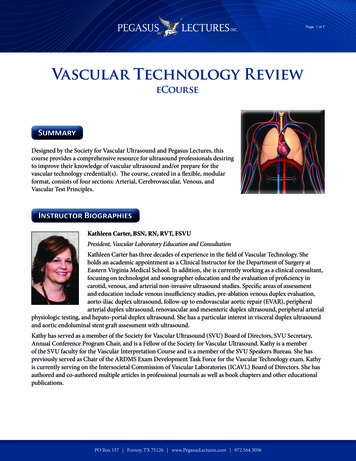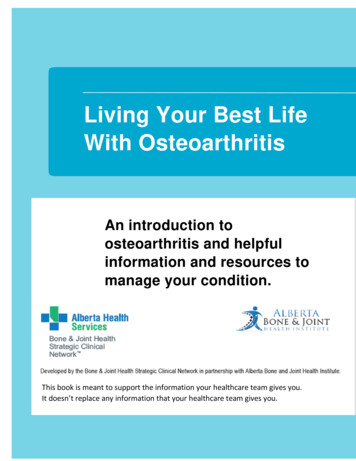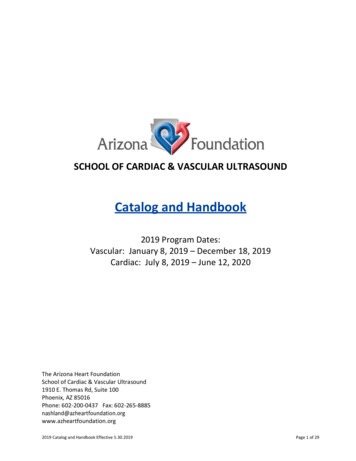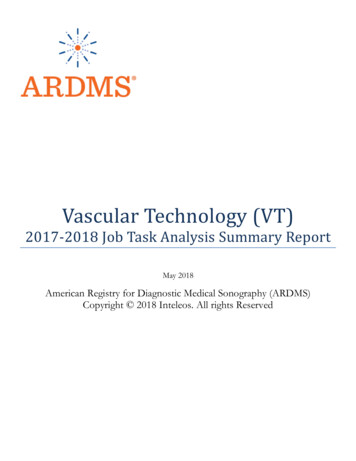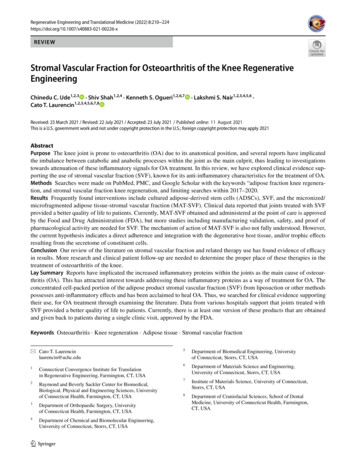
Transcription
Regenerative Engineering and Translational Medicine (2022) 6-xREVIEWStromal Vascular Fraction for Osteoarthritis of the Knee RegenerativeEngineeringChinedu C. Ude1,2,3 · Shiv Shah1,2,4 · Kenneth S. Ogueri1,2,6,7Cato T. Laurencin1,2,3,4,5,6,7,8· Lakshmi S. Nair1,2,3,4,5,6 ·Received: 23 March 2021 / Revised: 22 July 2021 / Accepted: 23 July 2021 / Published online: 11 August 2021This is a U.S. government work and not under copyright protection in the U.S.; foreign copyright protection may apply 2021AbstractPurpose The knee joint is prone to osteoarthritis (OA) due to its anatomical position, and several reports have implicatedthe imbalance between catabolic and anabolic processes within the joint as the main culprit, thus leading to investigationstowards attenuation of these inflammatory signals for OA treatment. In this review, we have explored clinical evidence supporting the use of stromal vascular fraction (SVF), known for its anti-inflammatory characteristics for the treatment of OA.Methods Searches were made on PubMed, PMC, and Google Scholar with the keywords “adipose fraction knee regeneration, and stromal vascular fraction knee regeneration, and limiting searches within 2017–2020.Results Frequently found interventions include cultured adipose-derived stem cells (ADSCs), SVF, and the micronized/microfragmented adipose tissue-stromal vascular fraction (MAT-SVF). Clinical data reported that joints treated with SVFprovided a better quality of life to patients. Currently, MAT-SVF obtained and administered at the point of care is approvedby the Food and Drug Administration (FDA), but more studies including manufacturing validation, safety, and proof ofpharmacological activity are needed for SVF. The mechanism of action of MAT-SVF is also not fully understood. However,the current hypothesis indicates a direct adherence and integration with the degenerative host tissue, and/or trophic effectsresulting from the secretome of constituent cells.Conclusion Our review of the literature on stromal vascular fraction and related therapy use has found evidence of efficacyin results. More research and clinical patient follow-up are needed to determine the proper place of these therapies in thetreatment of osteoarthritis of the knee.Lay Summary Reports have implicated the increased inflammatory proteins within the joints as the main cause of osteoarthritis (OA). This has attracted interest towards addressing these inflammatory proteins as a way of treatment for OA. Theconcentrated cell-packed portion of the adipose product stromal vascular fraction (SVF) from liposuction or other methodspossesses anti-inflammatory effects and has been acclaimed to heal OA. Thus, we searched for clinical evidence supportingtheir use, for OA treatment through examining the literature. Data from various hospitals support that joints treated withSVF provided a better quality of life to patients. Currently, there is at least one version of these products that are obtainedand given back to patients during a single clinic visit, approved by the FDA.Keywords Osteoarthritis · Knee regeneration · Adipose tissue · Stromal vascular fraction* Cato T. Laurencinlaurencin@uchc.edu1Connecticut Convergence Institute for Translationin Regenerative Engineering, Farmington, CT, USA2Raymond and Beverly Sackler Center for Biomedical,Biological, Physical and Engineering Sciences, Universityof Connecticut Health, Farmington, CT, USA3Department of Orthopaedic Surgery, Universityof Connecticut Health, Farmington, CT, USA4Department of Chemical and Biomolecular Engineering,University of Connecticut, Storrs, CT, USA135Department of Biomedical Engineering, Universityof Connecticut, Storrs, CT, USA6Department of Materials Science and Engineering,University of Connecticut, Storrs, CT, USA7Institute of Materials Science, University of Connecticut,Storrs, CT, USA8Department of Craniofacial Sciences, School of DentalMedicine, University of Connecticut Health, Farmington,CT, USA
Regenerative Engineering and Translational Medicine (2022) 8:210–224IntroductionOsteoarthritis (OA) has become the most prevalent jointdisease in the elderly population [1–4] as well as in youngactive individuals such as athletes and servicemen [5].Osteoarthritis most frequently affects the cells and tissuesin the knee joints, owing to its anatomical position andfunction, causing impairments in mobility and the qualityof life [3, 6]. Treatment strategies include targeting allthe affected regions of the joints to reduce joint pain andrestore normal functional capacities [6].Physical therapy is one early intervention for OA thathelps to strengthen the muscles around the joints attenuating pain and atrophy [7]. Data suggest that patients canalso benefit from knee braces and shoe orthotics [4, 8].Nutriceuticals, such as glucosamine and chondroitin sulfates, have also been beneficial in maintaining cartilagehealth and improving mobility [3]. Patients can benefitfrom oral non-steroidal anti-inflammatory drugs, as wellas corticosteroids and hyaluronic acid (HA) [9]. Fluoroscopic and ultrasound-guided neural blockade can beapplied to certain patients for pudendal and sympatheticnerve blockades [10]. However, when patients are not getting relief of their symptoms and their joint approachesend-stage degeneration, arthroplasty is recommended [8,11]. Arthroplasty has been beneficial, however, but it canbe accompanied by serious complications [6, 11].Early techniques to promote joint regeneration and cartilage self-healing have been focused on abrasion arthroplasty, microfracture, and subchondral drilling [4, 6]. Itwas believed that the released blood beneath the lesion cancontain native/pluripotent cells, linking bone marrow stemcells’ migration to elicit regeneration [12].Considering that OA is partly caused by the imbalancebetween the catabolic and anabolic processes within thejoints, several reports implicated inflammatory mechanisms to correlate with the cause of structural degeneration [13, 14]. This has led to exploring anti-inflammatoryactivities of cell/cellular products for OA treatment [1, 8,15]. The identification of resident native cells dates backto the 1860s when Cohnheim demonstrated the existenceof nonhematopoietic, plastic adherent, and fibroblastic-likecells from bone marrow for wound healing [16]. In the1960s, Friedenstein confirmed that the cells form colonies from single cells and coined the term colony-formingunit fibroblastic (CFU-Fs) [14]. Based on their ability todifferentiate into three mesodermal lineages, Caplan, inthe 1990s, named these CFU-Fs, mesenchymal stem cells(MSCs) [17, 17].MSCs are critical for tissue repair and in maintainingthe body’s homeostasis by having the ability to differentiate into different connective tissue lineages [13, 19]. MSCs211have been found in numerous tissues including bone marrow, umbilical cord blood, skin, muscles, periosteum, synovial membrane, and adipose tissues [20–23]. Recently,native cells in adipose tissues have attracted great attentiondue to their abundance in the body, ease of accessibility,and regenerative capabilities [16, 24]. Adipose-derivedstem cells (ADSCs), stromal vascular fractions (SVFs),and micronized/microfragmented adipose tissue-stromalvascular fractions (MAT-SVFs) are among the most frequently reported cell interventions [25]. These cellularproducts are believed to evoke their regenerative effectthrough the secretion of bioactive molecules that act in aparacrine fashion to prime and sustain angiogenic, antifibrotic, anti-apoptotic, and immuno-modulatory responsesin the target tissues [3, 10, 21, 26].This review focuses on recent clinical evidence of adipose-based SVF and MAT-SVF, their mechanism of action,limitations, regulatory challenges, and future directions ofthese cells on knee OA treatment.Adipose Tissues for RegenerativeEngineeringAdipose tissues can be harvested from various fat depots inthe body, namely, the abdomen, waist, thigh, hips, buttocks,and the infrapatellar fat pad of the knee joint [25, 27]. Theseare loose connective tissues composed of native uncommitted cells (adipose stem cells), preadipocytes (Adipose cellsprecursor), and mature adipocytes [24, 25]. In addition, adipose tissues contain stromal vascular-related cells, including fibroblasts, vascular endothelial cells, pericytes, and avariety of immune-related cells, such as macrophages andmonocytes [21, 28]. Their main role is to store energy inthe form of lipids, cushion delicate organs, and insulatesthe body [29, 30]. They can be classified according to theircolor and location in the body. The white adipose tissue,also known as visceral fat, organ fat, or intra-abdominal fat,which stores energy is located within the peritoneal cavity,packed in between the internal organs and torso [25, 25].The brown adipose tissues, which generate body heat, arelocated underneath the skin, known as subcutaneous fat, andinterspaced in the skeletal muscles, known as intra-muscularfats [25, 32]. Adipose tissue also constitutes part of majorendocrine organs and is hormonally active (active hormonesinclude, leptin, estrogen, and resistin) [3, 14].Adipose‑Derived TherapiesIn recent years, there has been an increased call by severalstakeholders to modify and clarify the different regenerative cocktails from adipose tissues and lipoaspirate [24].13
212In line with this, reports from various studies evaluating adipose-based therapies for knee joint degenerationscan be categorized into ADSCs, SVF, and MAT [12, 29].These different therapies will be discussed below.Adipose‑Derived Stem CellsAdipose-derived stem cells are native/undifferentiatedadipose tissue cells [16], uncommitted to any lineage orphenotype, and retain similarity to cells first identifiedin the bone marrow [22]. The earliest adipose-derivedstem cells were isolated from human liposuction aspirates called processed lipoaspirate (PLA) cells [33]. Theadipose-derived cells shared similar characteristics withMSCs [24], exhibiting plastic adherence, fibroblast-likemorphology, self-renewal, and capacity for multipotentdifferentiation [22]. It was then suggested that humanPLA cells were perhaps a clonal variant of the MSC,located within the adipose compartment; hence, thesemultipotent adipose-derived cells could be a suitablealternative for invasively obtained bone marrow stemcells (BMSCs) [20]. Many groups have designated different names to these cells [16, 20, 21]; however, theInternational Federation for Adipose Therapeutics andScience (IFATS) adopted the term adipose-derived stemcells (ADSCs) to identify them [6, 20]. ADSC utilitydepends on their in vitro expansion, which comes withits challenges, including possible loss of stemness andtransformation risks.Regenerative Engineering and Translational Medicine (2022) 8:210–224Stromal Vascular FractionStromal vascular fraction (SVF) is a collection of nonexpanded, heterogeneous cells and stromal tissues obtainedthrough liposuction [11, 31] that are derived through enzymatic digestion of lipoaspirate [16]. The SVF cell population includes hematopoietic cells, endothelial progenitors,endothelial cells, adipose-derived stem cells, adipose progenitors, fibroblasts, pericytes, immune cells, macrophages,leukocyte subtypes, lymphatic cells, smooth muscle cells,and other uncharacterized cells (Fig. 1) [10]. The percentageof ADSCs in SVF ranges between 1 and 15%; however,it may vary substantially depending on the patient’s age,health, and harvesting method [25]. Unlike ADSCs therapythat needs in vitro expansion, SVF does not need expansion[30, 32]. Other advantages of SVF include the heterogeneous cellular composition, which aids better therapeuticoutcomes [15, 20]. In addition, the presence of pericytes,in SVF, serves vital roles in regeneration by differentiatinginto activated MSCs in response to injury and inflammation[10, 32]. However, the isolation method for SVF, includingcollagenase digestion, erythrocyte lysis, and centrifugation,can negatively affect the original composition.Micronised Adipose Tissue‑Stromal Vascular FractionIn recent years, the need to address FDAs’ regulations prohibiting collagenase processed SVF products, coupled withinventions of intra-operative procedures that deliver autologous cells back into the patient without further processing,Fig. 1 A Different cells that make up SVF and MAT-SVF. B Cells, frequency of occurrence, and associated markers of SVF and MAT-SVF13
Regenerative Engineering and Translational Medicine (2022) 8:210–224led to the development of MAT-SVF [12, 14, 30]. MATSVFs are obtained from micromincing, fragmentation, andhomogenization of lipoaspirate adipose contents, withoutenzymatic digestion and cell expansion [16, 25]. The isolation procedure involves mechanical agitation, which breaksdown the component tissue matrix and releases the stemcells. The distinguishing factors of the MAT-SVF to SVFinclude the microvascular structure of extracellular matrix(ECM) that remains intact and the native adipose ECMstructure that provides a niche for other cellular subsets ofbioactive, enabling more biologic functions, cell migrationand modulation, cell signaling, interaction, and differentiation [7, 25]. Comparative studies have shown that enzymaticdisruption of adipose tissues resulted in a completely different composition compared to mechanical disruption ofadipose tissue, which mechanically condenses the tissueby selective removal of adipocytes without damaging keycomponents[2, 29]. However, the cellular yield from MATmethods is lower than those from the enzymatic SVF methods, as cells from adipose tissue are still bound by collagennetworks. It has been reported that the number of nucleatedcells in MAT-SVF and SVF methods may range between1 105 and 1.5 106 nucleated cells/mL respectively oflipoaspirate content [14, 33]Isolation and Characterizationof Adipose‑Derived TherapiesIsolation of SVF and MAT‑SVFA popular technique for isolating SVF from adipose tissues starts from liposuction [34]. The harvested adiposeis washed to remove lipoaspirate fluids. The fatty portionundergoes digestion with collagenase type 1. The digestsare separated into upper mature adipocytes with liquid fatfraction and lower cellular fraction. The cellular fractions arespun into a reddish SVF pellet [2, 24, 25]. Red blood cellsare removed from the pellets and the remaining total nucleated cells would be the SVF [13, 24]. Then, for MAT-SVF,instead of enzymatic digestion, the upper mature adipocyteswould be separated from the lower cellular fraction throughcentrifugation [25, 29]. The cellular fraction would furtherbe minced or mechanically agitated to microfragments torelease stromal cells [14].New processing kits/technologies have been developedby different cell therapy companies to obtain ready-touse, autologous SVF and MAT products (Fig. 2) (Table 1)[14, 16, 24, 29]. Simple non-enzymatic isolation methodsutilizing, physical forces, mechanical segregation strategies in gravity separation, centrifugation, and mechanicalemulsification have been favored to circumvent the safetyissues posed by enzymatic protocols [35]. Some of them are213optimized to provide greater cell viability, as well as a lowerpercentage of contaminants [15, 16]. Furthermore, in addition to the reduced production costs, protocol duration, andregulatory concerns, the non-enzymatic isolation methodshave improved precise separation by the use of automatedor semi-automated closed systems, to standardize operatordependent variations, thereby making isolation and therapeutic application more approachable in clinics [8, 30].Identification and Morphology of SVF and MAT‑SVFThe concentrated fractions of both SVF and MAT-SVFhave a reddish appearance; however, if SVF is treated witherythrocyte lysis buffer to remove red blood cells, the isolated fraction would appear less reddish. MAT on the otherhand contains more matrix in the pelleted concentrate, beingthat they were only microfragmented; hence, microvasculatures, reduced adipose clusters/adipose niche, and releasedexosomes remain intact [3, 28]. Despite mixed cell populations, they still contain a population that possesses the basiccharacteristics of MSCs [10]. Phenotypically, the International Society for Cellular Therapy (ISCT) and the IFATShave also established minimum criteria for the identification of SVF and MAT in relation to ADSCs (Fig. 1B) [20].Generally, surface markers of ADSCs are similar to those ofBMSCs with more than 90% overlap [33]. They have a positive expression to CD13, CD44, CD73, CD90, and CD105,and negative expression to CD31, CD45, and CD235a. However, ADSCs’ positivity for CD36 and negativity for CD106could be used to distinguish both cells [14, 33]. SVF couldbe characterized with the minimal criteria for MSCs, andin addition to CD45-, CD235a-, CD31-, and CD34 [10,14, 33]. After isolation, CD34 is found in 80% of SVF andMAT; furthermore, the positivity to CD34 increases to95% 2 days after the initial culture. However, the expression is lost during multiple expansions, hence the differencebetween CD34 and CD34 cell population could be usedto distinguish SVF, MAT, and cultured ADSCs [20, 33].Clinical Data for Knee Regeneration UsingSVFThe Stromal Vascular Fraction Treatmentfor Osteochondral Knee Defect: Case ReportA 36-year-old patient who sustained knee injuries skydiving was admitted with complaints of pronounced pain inthe right knee that got worse after physical exercise for upto 8 months, despite conservative treatments and physical therapy. Magnetic resonance imaging (MRI) indicateda traumatic osteochondral lesion of the medial femoralcondyle, an underlying significant bone bruise, with a13
214Regenerative Engineering and Translational Medicine (2022) 8:210–224Fig. 2 Devices used for SVFand SVF-MAT isolation. aGID-SVF1. b Puregraft 250. cStem.pras. d Reference method.Adapted from Jonathan Rodriguez et al., 2017 [35]high risk of osteonecrosis and posttraumatic osteoarthritis. Clinical examination revealed significant atrophy ofthe right thigh muscles and a range of motion between0 and 100 at the right knee. Pre-treatment arthroscopicevaluation showed a grade 3 local chondromalacia in themedial femoral condyle, and a mini-arthrotomy revealeda cartilage lesion of about 5 cm2. Microfracture was performed, in addition to 1.5 million autologous SVF cellsinjected with fibrin sealant Tissucol Kit, using a Duploject system. Results revealed a gradual reduction in pain,6 months post-treatment. The range of motion in the rightknee joint improved to 140 . The patient returned to theprevious level of physical activity, with mild periodic pain.Pre-treatment International Knee Documentation Committee (IKDC) score was 23; post-treatment, IKDC was 56 at3 months and 96 at 24 months [31].13Arthroscopic Findings of Cartilage and MeniscusRepairs after Injection of SVF in Knee Osteoarthritis:Case ReportA 54-year-old male occupational therapist had knee painin both legs for over 7 months. Conservative treatmentsfailed, leading to a gradual withdrawal from active sports.Physical examination showed mild swelling with a positiveMcMurray test and tenderness on the medial joint spacein both knees. X-ray and MRI showed Kellgren Lawrence(KL) grade II–III medial cartilage loss and the degenerationof medial meniscus. Pre-treatment diagnostic arthroscopyshowed a 2.5 1.5 cm cartilage defect at the right femoralcondyle with a grade III lesion according to the International Cartilage Repair Association (ICRS) classification.The left medial femoral condyle had a 3 1.5 cm cartilage
Semi-closedSemi-closedClosedClosedClosedAlloJoin TherapyADIPOA-2Transpose RT SystemAlloderm Cha-Station Multi-StationGID SVF-1Lipokit with MaxstemPuregraft 250Stem.pras with Duografter II Tulip Fat TransferCelution SystemCellthera Kit ICellthera Kit IILipogems processing kitClosedClosedClosedSemi-closedSemi-closedTissue Genesis IcellatorRe-Join TherapyCellthera, s.r.o., BrnoCellthera, s.r.o., Brno(Lipogems International Spa,Milan, Italy)Semi-closedSemi-closedSemi-closedcGTP cellular labCelution 800/CRSSepaxIntelliCell BioSciences IncCytori Therapeutics IncGE Healthcare (Biosafe GpSA)Tissue Genesis IncCellular Biomedicines, Inc.,ChinaCellular Biomedicines, Inc.,ChinaHuman med AG INCInGeneron, IncLifecell CO (Allergen PLC)PNC International Co., LtdPNC International Co., LtdGID Group, IncMedi-KhanEurosiliconeProteal Tulip medical productCytori ntrifugation, ation methodTable 1 A list of different cell therapy companies that have developed new processing kits/technologies for the SVF and MAT-SVF malMinimalMajor GIDzyme usedMinimalMinimalMinimalMinimalMinimalMajorMajor adipase usedMajorMinimalMajor-Celase usedMinimalManipulation VFMAT-SVFSuitable ClassRegenerative Engineering and Translational Medicine (2022) 8:210–22421513
216tear of ICRS grade III. Twelve million viable SVF cellswere injected into the intra-articular space of both kneesafter aspiration of 0.5 mL synovial fluid. Four weeks posttreatment, the patient reported knee pain reduction with animprovement of Knee Injury and Osteoarthritis OutcomeScores (KOOS) without any rehabilitation. Six months later,the patient returned to sports, and post-treatment arthroscopy showed regenerated cartilages on the medial and lateralcondyles in both knees [8].Arthroscopic Findings of Femoral and Tibial CondyleRepairs After Injection of SVF in Knee Osteoarthritis:Case ReportRegenerative Engineering and Translational Medicine (2022) 8:210–224group was slightly higher (61%), compared to SVF (55%). Itwas concluded that both groups (ADSCs and SVFs) resultedin clinical improvement in patients with knee OA; however,ADSCs outperformed SVF in the early reduction of symptoms and pain with few complications [19].Non‑Randomized, Phase I/II Trial to Evaluatethe Improvement in Knee Pain, Function,and Cartilage RestorationA 63-year-old with right knee pain for more than a yearhad continuous deterioration, and limitations in activesport, despite all conservative treatments including hyaluronic acid injections. Physical examination revealed mildswelling and tenderness on the medial joint space in theright knee. X-ray and MRI indicated osteophyte formation and degenerative changes on the medial meniscus.Pre-treatment arthroscopy showed partial-thickness cartilage tear of ICRS grade II, with 2 1.5 cm fibrillationin the medial femoral condyle and 1.5 1.5 cm in the tibial medial condyle. Five million viable adipose-derivedregenerative cells were injected into the intra-articularspace after synovial fluid aspiration. Pain and functionalrecovery improved 1 month after treatment without rehabilitation. Six months post-procedure, the patient returnedto active sports, and post-treatment arthroscopy showedcomplete regeneration on the medial femoral condyle, andrepair of the posterior horn of the medial meniscus [8].In a single-center, non-randomized, phase I/II trial toevaluate the improvement in knee pain, and function, aswell as cartilage restoration, 33 patients ( 38 years) withKL (III) knee osteoarthritis were evaluated. Patients withcommodities and intra-articular injections within 3 monthswere excluded. About 100 mL abdominal fats were harvested from each patient, with Triport Harvester Cannula, and 6 mL of SVF containing 90–120 million cellswere isolated. Microfracture was done by arthroscopy,and the knee joints were drained before the injection ofthe SVF. Follow-up results indicated a decreased trend invisual analog scale (VAS) score and Western Ontario andMcMaster Universities Osteoarthritis (WOMAC) index inthe SVF-treated group up to 24 months, as compared withthe placebo group. A significant increase in the Lysholmand a decrease in the Outerbridge Score (OS) scores wereobserved in the SVF treated group. The WOMAC scoreswere reduced in the KL3 groups, indicating more improvement in the KL3 group. Furthermore, the bone marrowedema (BME) was significantly decreased in the SVFgroup within 24 months [4].Level Three Cohort Clinical Trial of Adipose‑DerivedStem Cells and SVF for the Treatment of KneeOsteoarthritisDouble‑Blinded Randomized Study to Evaluatethe Efficacy of Intra‑Articular Injection of SVFfor Knee Osteoarthritis TreatmentIn a clinical study, cultured adipose-derived stem cells andnon-cultured SVF for the treatment of knee osteoarthritiswere studied in 80 patients. Forty-two patients (59 knees)received 1.28 107 ADSCs, and 38 patients (69 knees)received a 5 mL SVF injection. All patients had KL grade(2–4) knee osteoarthritis and had failed medical management. Follow-up evaluations were completed by the visualanalog scale (VAS) pain score and KOOS at baseline, and upto 6 months post-injections. The results indicated that SVFshad a higher frequency of knee effusion (8%), compared toADSCs (2%), and harvest site complications, SVF (34%),and ADSC (5%). In the ADSC treated group, pain VASand KOOS domains improved by 3 months, and pain VASdecreased by 55% compared to the SVF group (44%). Theproportion of Outcome Measures-Osteoarthritis ResearchSociety (OMERACT-OARSI) responders in the ADSCThirty-nine patients between 40 and 75 years old with symptomatic knee OA were recruited into three groups: high-doseSVF (3.0 107 cells), low-dose SVF (1.5 107 cells), andplacebo group (zero cells). SVF was injected intra-articularly. WOMAC and MRI evaluations were obtained preoperatively. At 6 months post-injection, WOMAC scoresfor each group were 83.9% for the high-dose group, 51.5%for the low-dose group, and 25.0% for the placebo group.The high- and low-dose groups had statistically significantchanges compared with the placebo group. Furthermore,the median percentage changes in WOMAC from baselineto 1-year post-treatment for the high-dose, low-dose, andplacebo groups were 89.5%, 68.2%, and 0%, respectively,reflecting that the high- and low-dose groups had greaterchanges at 12th months compared with the placebo; however, the improvements were dose-dependent [3].13
Regenerative Engineering and Translational Medicine (2022) 8:210–224Double‑Blind Randomized Self‑ControlledTrial Comparing the Efficacy of AutologousAdipose‑Derived SVF Versus HASixteen patients with bilateral symptomatic knee osteoarthritis (KL grade II–III) were randomized into two groups. Eachpatient received a single dose of SVF injection in one kneejoint (test knee, n 16) and HA in the contralateral knee(control knee, n 16). Patients were seen for follow-up at 1,3, 6, and 12-months post-injection. The SVF-treated kneesshowed significantly improved mean VAS, WOMAC, andrange of motion (ROM) scores at 12 months, compared tobaseline; the HA group became worse. Whole organ magnetic resonance score (WORMS) and magnetic resonanceobservation of cartilage repair tissue (MOCART) measurements revealed significant improvements in cartilage repairin SVF-treated knees compared with HA knees, suggestingthat autologous adipose-derived SVF can improve functionand repair cartilage defects of knee osteoarthritis [9].Long‑Term Multi Centric Case Study on the Efficacyof SVF for OA in Very Elderly Population WhoseConservative Managements Have FailedA total of 29 patients, between 80 and 94 years old (males31.1%, and females 68.9%), were recruited to evaluate theefficacy of SVF. Initial evaluation utilizing the K-L scale,clinical examination, X-ray, and/or MRI revealed that 10.3%of the patients were at grade 2, 48.3% with grade 3, and 41.4%with grade 4 degenerations. SVF was intra-articularly or periarticularly administered into the knee or other affected joints.Complex score evaluations (pain, number of analgesics/NSAIDs per week, limping at a walk, joint stiffness, and extentof joint movement) by the modified Knee/Hip OsteoarthritisOutcome Score (KOOS/HOOS) depicted pain as well as thetotal amount of NSAIDs were significantly decreased fromthe first-month post-SVF therapy and significantly decreased36 months post-SVF therapy. Similar results were obtainedon limping at a walk, extent of joint movement, and stiffness.Data suggests that SVF represents an important tool in theregeneration of joints in elderly patients [11].Clinical Evidence of Knee RegenerationsWith SVF‑MATRetrospective Observational Studyon the Treatment Efficacy of Autologous MATfor Diffuse Degenerative Knee OsteoarthritisThirty patients with different degrees of diffused degenerativechondral lesions were treated in the study. About 24 patientshad an associated anterior cruciate ligament/lateral cruciateligament (ACL/LCL) reconstruction, high tibial osteotomy,217and meniscectomy, while 6 had undergone arthroscopy. Clinical outcomes were determined using KOOS, InternationalKnee Documentation Committee (IKDC)-subjective, Tegner Lysholm Knee, and VAS pain scales. Improvement of 10points was selected as clinically significant. Results revealedno relevant complications and a total of 20 points medianimprovement in IKDC and KOOS scores. Furthermore,improvements were also recorded in VAS pain and TegnerLysholm Knee, 21 and 31 points, respectively, thereby supporting the safety and feasibility of autologous MAT in treating diffuse degenerative chondral lesions [7].In a 3-year follow-up, all 30 patients shared the presen
and given back to patients during a single clinic visit, approved by the FDA. Keywords Osteoarthritis · Knee regeneration · Adipose tissue · Stromal vascular fraction * 5Cato T. Laurencin laurencin@uchc.edu 1 Connecticut Convergence Institute for Translation in Regenerative Engineering, Farmington, CT, USA

